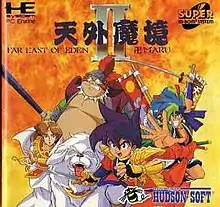Tengai Makyō II: Manji Maru
Tengai Makyō II: Manji Maru (天外魔境II卍丸, lit. "The Devil's Cave Outside Heaven: Manjimaru"), also known as Far East of Eden II: Manji Maru, is a role-playing video game and the second game in the Tengai Makyō series. It was first released in 1992 for the PC Engine Super CD-ROM² by Hudson Soft and developed by Red Entertainment. It was remade in 2003 by Hudson for the GameCube and PlayStation 2, and a version was released for the Nintendo DS in 2006. All versions of the game were released only in Japan.
| Tengai Makyō II: Manji Maru | |
|---|---|
 PC Engine manual art | |
| Developer(s) | Red Entertainment |
| Publisher(s) | Hudson Soft |
| Director(s) | Shōji Masuda |
| Designer(s) | Shōji Masuda |
| Composer(s) | Joe Hisaishi Yasuhiko Fukuda |
| Platform(s) | PC Engine Super CD-ROM², GameCube, PlayStation 2, Nintendo DS, PlayStation Network (PCE-CD version, for PS3 and PSP)[1][2] |
| Release | |
| Genre(s) | Role-playing video game |
| Mode(s) | Single-player, multiplayer |
Story
The setting starts in a beautiful country named Jipang where the Fire clan and Roots clan have been rivals over centuries since the dawn of time, good versus evil. The home town of Manjimaru Sengoku, a descendant of the Fire clan, is attacked by the Roots clan. He begins a long journey to save the world. Along the way he will meet Danjūrō Kabuki, Tarō Gokuraku and Kinu to help him in his quest.
Characters
- Manjimaru Sengoku (戦国卍丸 Sengoku Manjimaru): A playful kid that runs around his village with the other kids to discover new adventures around his hometown. It wasn't until the Roots clan army invades his village that his mother finally tells him the heroic past of about his father. His father was one of the legendary 7 swordsman of the Fire clan whom defeated the previous era of Roots clan's domination. And now it's his turn to become a heroic man like his father and save the world from the Roots clan once again.
- Danjūrō Kabuki (カブキ団十郎 Kabuki Danjūrō): A loud mouthed, goofy, bit narcissistic, ladies' man Japanese kabuki performer who would add a touch of "color" to Manjimaru's journey. Kabuki is an excellent swordsman who carries a pair of traditional Japanese swords (one long and one short).
- Tarō Gokuraku (極楽太郎 Gokuraku Tarō): A fire breathing joyful giant with a huge appetize. Gokuraku is over a thousand year old, and was living in Mermaid clan's captivity till Manjimaru comes along.
- Kinu (絹): An innocent quiet girl with a tragic past. Kinu is actually half demon that is in fear of the great power within her and what she is capable of. She asked Manjimaru to bring her a special magic seal wrist chains before she joins him on his journey. Kinu travels with a huge white fluffy dog named Shiro who's been with her since she was a kid, her only friend as a child.
Development
Tengai Makyō II, previewed in a 1992 issue of TurboPlay magazine as Ziria: Far East of Eden 2, was reportedly the most expensive game ever made up until that time. The game world consists of over 20,000 screens of overworld maps. The game also features 300 types of enemies, 48 different boss characters, more than 90 minutes of cutscene animation, three hours of voiced speech, 24 CD music tracks, and over 80 PSG chiptune music tracks.[3]
Tengai Makyō II was never published outside Japan, though Victor Ireland, president of Working Designs (an American publisher which had localized a number of other RPGs for the PC Engine CD-ROM) ranked it number 1 on his personal list of the greatest games of all time.[4]
Reception
In a 2006 poll, readers of Famitsu magazine voted it the 12th favorite video game of all time.[5]
References
- "Tengai Makyō II: Manjimaru". Japanese PlayStation Store (in Japanese). Sony. Retrieved November 9, 2012.
- "Tengai Makyō II: Manjimaru". PC Engine Archives (in Japanese). Hudson Soft. Retrieved November 9, 2012.
- TurboPlay, April/May 1992, page 19
- "Victor Ireland: President of Working Designs". Electronic Gaming Monthly. No. 100. Ziff Davis. November 1997. p. 141.
- "Japan Votes on All Time Top 100". Edge-Online.com. March 3, 2006. Archived from the original on July 31, 2009. Retrieved 2008-12-13.